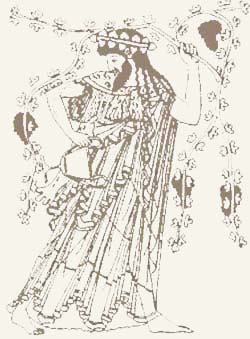The Grapevine Art & Soul Salon
Musings on Being and Becoming Human

Issue 12
Spirit and Soul: Discernment
The words spirit and soul are often used interchangeably to refer to that elusive aspect of human nature that cannot be accounted for scientifically but counts nevertheless among the wonders of the world, attended to with religious zeal and artistic fervor and romantic love. The Greek word for soul is psyche, and from that comes our word psychology, so that the study of psychology can be seen as soul study, which it usually is not, except by James Hillman, a Jungian analyst and the founder of archetypal psychology. Hillman's work is as important to artists as to psychologists. He is seen by some, including me, as one of the most important thinkers of the past 50 years, if not the most important one. The description of soul that I want to lay out here comes from his work, which is well represented in a book of excerpts selected and discussed (with Hillman's collaboration) by Thomas Moore, editor of A Blue Fire (New York: Harper Collins, 1989). Keep in mind that this discussion could fill more than one book. I will sketch briefly the features of soul that bear upon some if not all of the writing for this issue of The Grapevine.
One way to begin is to contrast spirit and soul, using the metaphor of peaks and vales as Hillman does, noting that he has taken this passage from John Keats, in a letter to his brother, as a psychological motto: "Call the world, if you please, the vale of soul-making. Then you will find out the use of the world." Here is Thomas Moore's summary (112) of Hillman's position:
Soul, Hillman says with his metaphor of peaks and vales, resides in the valleys of experience. Soul is always tethered to life in the world. It can't be separated from the body, from family, from the immediate context, from mortality. Spiritual efforts, important in their own right, tend to transcend these limitations of the valley. Motivated by spiritual concerns, men and women leave their families to join dedicated communities. They focus their attention on afterlife, cosmic issues, idealistic values and hopes, and universal truths. They try to perfect the body with yogas and diets and demanding exercise routines. Spirit is to be found not only in church, but also in the gym, on the corporate ladder, and in higher education.
Soul, on the other hand, is always in the thick of things; in the repressed, in the shadow, in the messes of life, in illness, in the pain and confusion of love (113).
To these brief excerpts I would add D. H. Lawrence's comments on the work of Walt Whitman in Studies in Classic American Literature (New York: Viking Press, 1961, 171-2). Lawrence considers Whitman to be the first to smash "the old moral conception" that the soul of man is something "superior" and "above the flesh."
Whitman was the first heroic seer to seize the soul by the scruff of her neck and plant her down among the potsherds.: "There!" he said to the soul. "Stay there!" Stay there. Stay in the flesh. Stay in the limbs and lips and in the belly. Stay in the breast and womb. Stay there, Oh Soul, where you belong".
Whitman sang of the soul in places that are imperfect and rejected, sick, down and earthy, dark and erotic.
The Open Road. The great home of the Soul is the open road. Not heaven, not paradise. Not above. Not even within. The soul is neither above nor within. It is a wayfarer down the open road.
"I loafe and invite my soul," he says, giving us the pacing we need to attend to things of the soul, the reclining posture that invites soul to come and be received.
Our writing in this issue is about looking for soul in the thick of things: in the repressed, in the shadow, in the messes of life, in illness, in the pain and confusion and of love, in the body, among the animals, among the potsherds and on the open road, in blood-drenched battlefields and open air monuments to life and fecundity, in paeans to love and creativity.

AT HOME here are writers speaking in a style more conversational than studied for an audience who might be seated on a front porch at night watching fireflies create random small rays to light up the listening, or in the dining room of an ancient inn with lamps and perhaps a hearth fire to kindle community.
It takes only one or two steps of the imagination to move through the dusk to the dining room at the inn or the porch of a house or, by daylight, to a backyard garden for picking grapes and for gossiping, a verbal mode associated with the term grapevine. We say I heard it on the grapevine, referring to rumor, advance news of interest to the community, sometimes scandal, always a dramatic story or piece of a story, circulating, making the rounds, lingering on the surface even when it suggests hidden things.
The SALON presents a variety of storytellers and image makers and thinkers, from promising beginners to seasoned artists of mature and full-bodied talents.

Link to New Millennium Writings Facebook Page
The Grapevine Art & Soul Salon welcomes comments from visitors. Use the Contact button to send e-mails that will be forwarded to appropriate persons. If your computer is not configured for Outlook Express, simply copy and paste the webmaster's address into your e-mail system. All our regular contributing writers can be e-mailed directly (click on Presentations page and scroll down for links and e-mail addresses).
Opinions expressed on this site are the opinions of the authors themselves, not necessarily of The Grapevine Art & Soul Salon. Each page on this website should be read in conjunction with this disclaimer.
Image Design: Bill Kennedy
Contributing Writers: Jonathan Knott, Ravi Kumar, Bill Kennedy, Nancy Law, Anne Lovett, Charles Knott, Anne Webster
Copyright ©2010 Barbara Knott ·